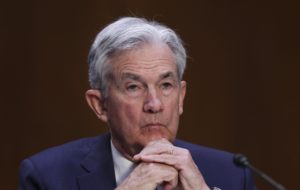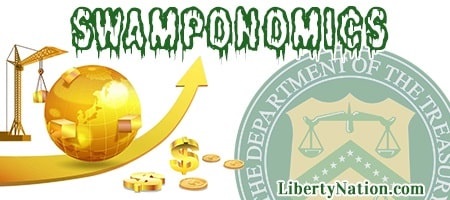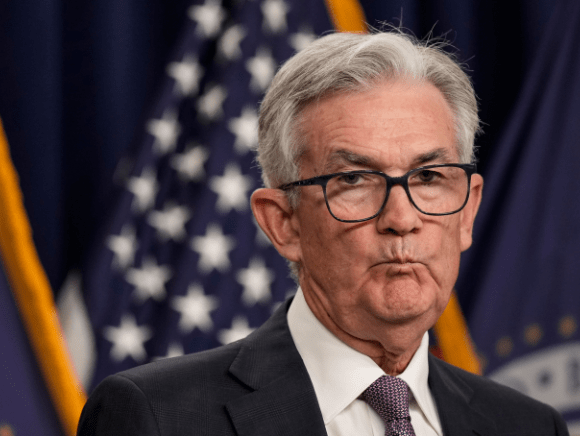Federal Reserve Chair Jerome Powell tried his best to resuscitate the financial markets during his post-Federal Open Market Committee (FOMC) press conference. While he had some luck during his powwow with business reporters, investors could not be persuaded to HODL as the cool kids on Wall Street Bets say. As a result of the US central bank’s tightening efforts, the leading benchmark indexes tanked faster than the Boston Red Sox in the standings to close out the trading week. Is this what is in store for the rest of 2022? Probably unless there is divine intervention from the market gods.
Jerome Powell Tosses a Bone
Once again, the Eccles Building failed to channel the spirit of ex-Chair Paul Volcker and chose to pull the trigger on a boring 75-basis-point hike to the fed funds rate (FFR). Rate-setting Committee members also raised the dot-plot – a chart of where officials think interest rates will be in the coming years – affirming the recent mantra of “higher for longer” rates. But what caught everybody’s attention was Powell’s comments during his presser. Early in the news conference, Powell made an eyebrow raising and rally-inducing remark about the pace of tightening.
 “[A]t some point as the stance of policy tightens further, it will become appropriate to slow the pace of rate hikes while we assess how our cumulative policy adjustments are affecting the economy and inflation,” he told journalists. What’s more, he made this statement twice.
“[A]t some point as the stance of policy tightens further, it will become appropriate to slow the pace of rate hikes while we assess how our cumulative policy adjustments are affecting the economy and inflation,” he told journalists. What’s more, he made this statement twice.
Anyone with a live ticker of the Dow Jones Industrial Average and Powell’s presser would see ebullience when he uttered these words. But the relief was short-lived because traders then realized that rates were now more than likely going to trigger a sharp economic downturn. The soft landing fantasy is about as realistic as the romance in 50 Shades of Gray, especially when it appears that Powell and his fellow central bank colleagues are coordinating monetary policy (see below).
At the end of the trading week, the Dow Jones slipped into a bear market territory, which is defined as a 20% loss, before paring some of its losses. It also fell below 30,000 for the first time since November 2020. The Nasdaq Composite Index slipped under 11,000, while the S&P 500 declined to around 3,600. It was ugly as red ink engulfed most of Wall Street. Gold plunged 1.75%, US crude oil lost 4.87%, and Bitcoin tumbled 2.5%. The US Dollar Index (DXY), which measures the greenback against a basket of currencies, skyrocketed close to 2% to top 112.00. The two-year Treasury yield hit a 15-year high of 4.2%, while the recession-indicating spread between the two- and ten-year yields widened to -50 basis points.

Jerome Powell (Photo by Win McNamee/Getty Images)
A Meatball-Sized Hike
During the week of central bank festivities, the Swedish Riksbank made Jerome Powell blush by delivering a supersized rate hike of 100 basis points. Economists had anticipated that Sweden would emulate other nations and pull the trigger on a three-quarter-point increase. Instead, the Riksbank brought the policy rate back to where it was about a decade ago and signaled that it would keep raising rates for the next six months. Conditions are bleak in the home of Ingmar Bergman films and August Strindberg plays: the krona is at a 21-year low, inflation is north of 8%, and the economy is showing signs of weakness.
No Country for Old Yen
The Bank of Japan (BoJ) bucked the international trend of tightening by keeping its benchmark rate at -0.1%. This means that Tokyo is the only advanced economy to be selling negative-yielding bonds. However, despite the lack of action on interest rates, investors were taken aback by the BoJ intervening directly in the foreign exchange markets to purchase the yen. The objective was to defend the yen against the US dollar, the best currency in global forex markets. This was the first currency intervention since 1998, with the yen losing about 25% of its value against the buck. Ultimately, policymakers are more concerned about the yen than ultra-dovish monetary policy.
Turkey Talk
What is happening in Turkey? Nobody knows at this point. Despite an annual inflation rate topping 80%, President Recep Tayyip Erdogan’s central bank cut interest rates for the second consecutive month by 100 basis points, lowering the benchmark to 12%. The institution also slashed the overnight lending rate and overnight borrowing rate to 13.5% and 10.5%, respectively. This is part of Erdoganomics, an orthodoxy that defies traditional economics. The president believes that the central bank can successfully fight inflation by growing the economy through policy easing. Genius. He should quickly inform Jerome Powell and let him know of this magical panacea. No longer will Americans need to pay 13% more at the supermarket.
 Put the Kettle on
Put the Kettle on
Other central banks convened and pulled off other boring stunts. The Bank of England (BoE) opted for a half-point hike while also putting forward about $85 billion in quantitative tightening (QT). Oh, and the central bank declared that Great Britain was in a recession. The Norwegian central bank moved ahead with a 50-basis-point increase, although it hinted that these tightening efforts might come to an end. Indonesia, the Philippines, Vietnam, South Africa, and Taiwan all raised interest rates to fight rampant price inflation.
Everyone is wondering if these actions will work. Well, there are two things. The first is that Treasury Secretary Janet Yellen has already conceded that the US will not reach its 2% target rate goal next year. The second is that the real interest rate (inflation-adjusted) is still in negative territory in all but four countries (Brazil, China, Hong Kong, and Saudi Arabia). Everywhere, the central bank policy rate is negative. By comparison, the last time inflation was this high in the United States, the Fed brought the FFR to as high as 20%. Can Powell and Co. Get inflation under control? Powell’s post-FOMC meeting attitude was not as confident as when he insisted for a year that an elevated consumer price index (CPI) or personal consumption expenditure (PCE) price index was transitory. Inflation beat not only businesses and consumers, but the Swamp monsters, too.




